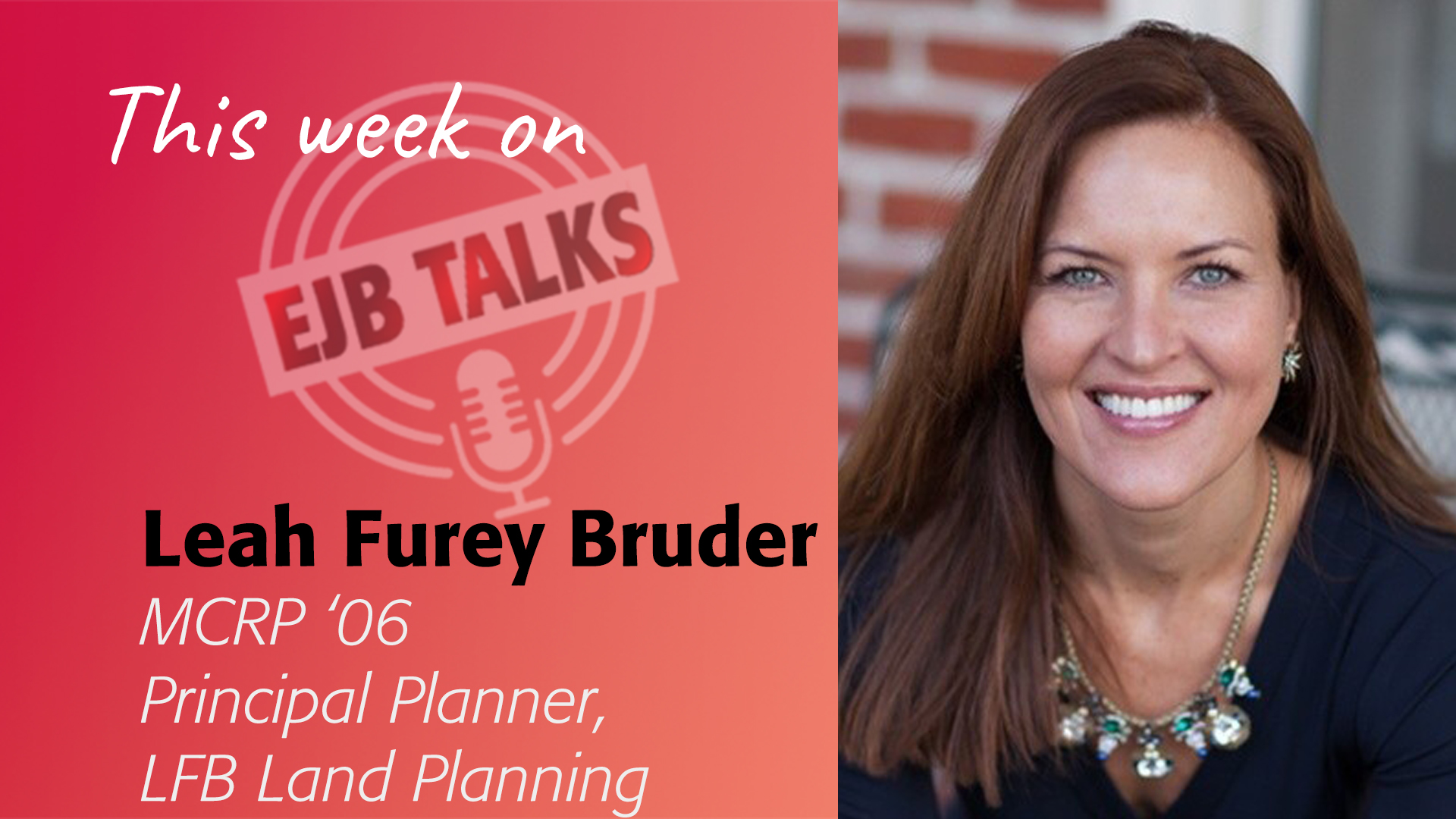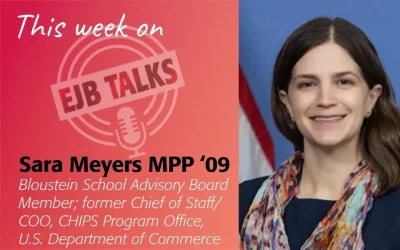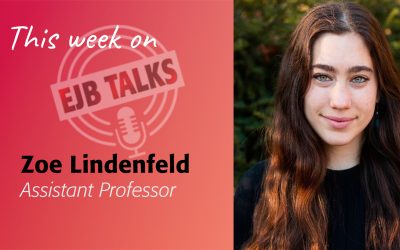Balancing Growth and Preservation: Leah Furey Bruder, MCRP ’06 on Community-Centered Urban Planning
This week on EJB Talks, Dean Stuart Shapiro speaks with Bloustein School alumna and Bloustein Advisory Board member, Leah Furey Bruder, MCRP ’06 about her journey into urban planning and her experiences working in municipal and redevelopment planning. Leah explains how her background in international studies shifted to local planning after working on community development in Camden, NJ. She discusses her work in Cherry Hill, her time as an in-house municipal planner in Evesham Township, and her decision to start her own firm to focus on impactful projects. She highlights two key projects: the redevelopment of aging shopping centers into vibrant mixed-use spaces, and the successful opposition to a large-scale development that threatened New Jersey’s agricultural land. She emphasizes the complexity of planning, balancing economic, environmental, and housing needs, and the importance of working with community stakeholders. She concludes by advising students to gain diverse experience, acknowledge their knowledge gaps, and navigate the complexities of competing interests in planning.
Transcript
Stuart Shapiro
Welcome to EJB talks. I’m Stuart Shapiro, the Dean of the Bloustein School. And the purpose of this podcast is to highlight the work of my colleagues and our alumni in the fields of planning, policy and health, and the work they’re doing to make the world a better place.
Today I’m speaking with one of our accomplished alumni from our world-ranked urban planning program, Leah Furey Bruder. Welcome to the podcast, Leah!
Leah Furey Bruder
Thank you very much. I’m happy to be here, Stuart.
Stuart Shapiro
So, let’s start with origins. How did you become interested in urban planning?
Leah Furey Bruder
Well, yeah, let’s go way back. I did my undergraduate degree at American University in the School of International Studies. So while I was there I expected my career to go down the path of international development or foreign policy. And I did, while I was in DC, I did a number of mini-internships at the State Department, Voice of America, the White House.
And you know, I became more interested in international development. And then I began a Master of Public Administration at Rutgers. And while I was in that program, I worked, briefly, as a sort of like an intern at a non-profit in Camden that was working on housing rehabilitation and community development work. And that was really my first introduction to city planning, neighborhood planning domestically.
I had always had my focus on doing international work and I really didn’t know anything about city planning or community development. But my father was a builder, so I had a little bit of understanding of that world. And then once I started working at the nonprofit in Camden, it kind of gave me a peek into the world of city planning. And at the same time I started noticing and taking particular note of places, suburban places, that didn’t have much character, like shopping centers, that could just, sort of be, repeated. Like picked up and put into another place and you wouldn’t know where you were.
And I started just thinking more about community planning on a local level. So I got a job, then, in a big suburban community in southern New Jersey, Cherry Hill. I’m sure a lot of people know of it. And while I was there, I was working for the mayor. And there was a huge learning curve, you know. It was like, trial by fire. I was just put into all kinds of situations that I’d never been in before, and thigs I didn’t know about in the Community Development Office. And I really enjoyed it, but I realized that I still had a lot more to learn. And that is when I started my master’s at the Bloustein School. And it took me, you know, a few years. I was doing that part time while I was working.
But from there, you know, I launched into my community development and planning career.
Stuart Shapiro
Gotcha. And then afterwards, if I’m right, you went back and you did work at at least one more small town or one more town here in in New Jersey? Talk about that and talk about, sort of, what you took from the experience of working in Cherry Hill and where you worked after graduation.
Leah Furey Bruder
Yeah. After, I then also worked at an engineering and planning firm. And so I ended up having quite a few different municipal clients and where I got to do a variety of work for these towns throughout southern New Jersey. For the most part, you know, I would work with the planning and zoning boards to review development applications and do master plans. Worked with them on environmental resource inventories and you know, kind of the broad spectrum of planning.
And then I took the particular interest in redevelopment planning. So I worked, again, with a number of different towns throughout New Jersey for several years, and I also got involved with working for some private developers on development projects that they were working on throughout southern New Jersey. And I ended up landing, one of my main municipal clients was a big town in southern New Jersey, Evesham Township, otherwise known as Marlton.
And I ended up working in house there for several. And I did all manner of municipal planning there. And again, I focused a lot on redevelopment planning you know, which is, you know, essentially looking at spaces and places that have been formerly developed and that have become, you know, obsolete. Maybe have experienced decline and disinvestment and try to draw some attention to those places so that new life can be breathed into them. So from a municipal side, we would do some redevelopment planning for those places and then work with private developers who were interested in making investments there.
Stuart Shapiro
Gotcha. What made you decide to start your own firm after that?
Leah Furey Bruder
Well, while I was working in Evesham, I had a little spare time to do a little bit of side work in other municipalities, you know, for private developers. And while I was doing this work, I started thinking about how nice it was to be able to really choose the projects that I want to work on and really try to advance projects that, you know, felt like they were impactful and important. And then of course, there was some personal aspect to it as well, which was my family and it was, I thought about having, you know, more flexibility in my schedule. So I started my own firm, in earnest, full time in 2019.
Stuart Shapiro
So when you say impactful and important, what do you mean?
Leah Furey Bruder
Well, planners can get involved in a lot of different types of projects. You know, ranging in size from small to large. Working for private developers or for me, it’s been municipalities, but of course there are planners in county government. And then of course at the state level. And for me, I was… I have found that I’ve been able to have the most impact working at the local level on projects that I feel, kind of balance competing policy demands and priorities.
So, you know, I might say no, I don’t want to work a project that I feel is like too focused on one priority at the expense of others. So I seek to, you know, try to work on projects that balance economic development, housing needs, environmental impact and you know, working on my own I’m able to choose those projects.
Stuart Shapiro
So can you give us an example of a project that was impactful or important and that you really enjoyed working on?
Leah Furey Bruder
Certainly. So maybe I’ll maybe I’ll do two.
Stuart Shapiro
OK, perfect!
Leah Furey Bruder
The first one, I guess, something that comes to mind from a redevelopment standpoint is that, is working in Evesham Township on redevelopment off what we would call “grayfields.” Which are shopping centers that are kind of like big parking lots. Shopping centers that are dated and somewhat obsolete, and they may have a lot of vacancies.
And we focused on some of these areas and did some redevelopment planning for them. Worked with the property owners to enable mixed-use developments that have commercial aspects. Housing, affordable housing, you know, create beautiful spaces and enable a sense of community and create some character in all around the downtown area. So in order to, you know, create more density in places where density makes sense.
So that that’s a redevelopment project that has come to fruition that I worked on that I think was pretty successful. And then another extreme is that I’ve recently had a wonderful experience working with one of my municipal clients that is a rural town. That has focused its policy priorities primarily on the preservation and retention of agriculture and farm land.
Stuart Shapiro
Mm-hmm.
Leah Furey Bruder
And you know, it’s in the farm belt of New Jersey where, you know, there are… certainly everything in New Jersey is relatively close together. So when we say, you know, it’s rural, it’s all relative. But it is an area where both the town, the county and the state have really wanted to focus the preservation of farmland and the agricultural industry. And a developer came along and proposed to build a very large development in the town and of course the way that developers often do this is that they use the affordable housing mandates as the driver behind what they’re trying to do.
Stuart Shapiro
Yes.
Leah Furey Bruder
So they propose very large developments that would have included some affordable housing. But this was in area where there are there is very little infrastructure. There are country roads, there is no water infrastructure, no sewer infrastructure. It’s surrounded by, primarily, other farms. Some of them are preserved and so the town decided to go to bat against this proposal.
And you know, we did end up in court and there was a lot of testimony. There were expert reports. But at the end of the day the township prevailed. Because we were able to demonstrate to the court that, while there are many competing priorities in planning, always, that everything is interconnected. And in this case, it did not make sense to focus on one priority which was affordable housing at the expense of everything else. When there are, you know decades-long history of public investment in the preservation of farmland and you know, the state plan supports agriculture in this area. It was not efficient to extend infrastructure all the way out to this area where,, you know it would basically be leapfrogging development that would break up large areas of contiguous farmland.
So in this case, we and the township did prevail. And you know, this developer did not gain the right to develop in this area. And it really was a big win for those who advocate for, you know, preserving agriculture in New Jersey and ensuring that we have a stable base of agriculture. So, that, I think is something that I worked on recently that was very impactful.
Stuart Shapiro
So you talked about the interconnectedness and the balancing of priorities. You talked about two very different projects there. You know, when you think about different projects, how do you balance those priorities? How do you say, OK, in this case, affordable housing isn’t right for this area, but in this case it’s perfect for this area? What sort of the thought process you go through?
Leah Furey Bruder
That’s a really good question and I would say that different people would probably answer it differently. You know, in planning there is some science and some art involved. A,nd you know, we’re always kind of evaluating what the various policy priorities are in any one area. And then we have to decide, you know, which ones take precedent given the specific context.
And usually I’d say in a local context, you know, we take our cues sometimes, from the elected officials. We understand what their policy priorities are. And sort of take those threads and put them together with what we, as planners, know from the bigger picture. And try to… And again, there’s no perfect answer. But in engineering, you know—I often work with civil engineers. In engineering, there are right answers oftentimes, and there are wrong answers. You know, there is math and there is physics, and engineers come up with solutions that are more, physical based. Whereas planners have to be mindful of all of that, but also have to think about the bigger picture.
In planning everything is interconnected. So we’re always thinking about the physical space, the character of the area, maybe the history of an area. Design, the need for open space, and environmental protection. You know, we’re thinking about all these competing priorities at once and we really just have to take all those… all the context into consideration and look at the history of planning in the place as well.
Stuart Shapiro
How much politicking is there? In other words, you’re trying to do some sort of educating, of course, about requirements and what has to be done and what good planning would dictate. But I also imagine you run up against competing values a lot of the time. And how much of that is a challenge in the work you do?
Leah Furey Bruder
It’s a big challenge because, like you know, again I speak from my experience, which is primarily at the local municipal level. Local policy and decision makers, like governing bodies, planning board members, zoning board members, agriculture development board, environmental commission members. All these people on these various boards and committees are serving because they care about their communities. And they have an interest in their communities. But for the most part professionally they’re involved in something.
They’re serving as volunteers, so they may have… I mean, sometimes you’ll have a board member that’s an architect or a planner or an engineer, or a lawyer, land use lawyer. And they have a lot of relevant experience. But oftentimes that’s not the case. And so, it’s our job as professionals to, you know, sort of understand what their priorities are and then also provide information back to them so that they make the best educated decisions that they can.
And I find that, again, planning happens in the public realm at public meetings. You know, we do a lot of work behind the scenes. But the culmination of our work is almost always at a public meeting.
Stuart Shapiro
Mmm hmm.
Leah Furey Bruder
And the members of the public have an opportunity to speak, to voice their opinions. But they’re emotional, you know? To them it’s, you know, their investment in their home, or their business. And they have facts to share. But they also feel emotional about those things. Any number of times I’ve heard from a member of the public, well, you don’t live here. And it’s true, I don’t. But I also have been doing this, you know, professionally for some time, and I’ve learned how to, sort of like, sift out what are the emotions and what are, you know, the factors that come into play for policymaking.
Stuart Shapiro
Great, yeah. I’m sure that takes a lot of work. So what, sort of, given all of these aspects, all this interconnectedness, all these challenges. What message would you give to our students?
Leah Furey Bruder
Well, I would say to get experience in a variety of settings if you can. And to always know what you don’t know. You know, a lot of times we get we gain our expertise, but I think in planning, especially we… just because we’re taking so many factors into consideration, we also have to weigh the expertise of others. And so, we always have to acknowledge what we don’t know.
And then to know that, you know, there are good guys and there are bad guys in terms of stakeholders. But most people are somewhere in between. And, you know, we need to find a way to balance everyone’s interests in order to… for the public interest. So that’s kind of like the balancing test that we’re always working on. You know, we have municipal interests, private interests. Any number of different special interest groups are interested in land use and community development, and it’s our job to sort of, facilitate and try to bring them together. And I think that’s when we find the most success.
Stuart Shapiro
Well, I’m going to wrap up, but boy, you left me wanting to hear more about the good guys and the bad guys. ((laughing)) Maybe the subject for the next time we have you on.
Leah Furey Bruder
Right, right!
Stuart Shapiro
Leah, thank you so much for coming on today!
Leah Furey Bruder
All right!. Thank you for having me!
Stuart Shapiro
I’d also like to give a big thank you to Tamara Swedburg and Karyn Olsen, who work to make the podcast a reality. We’ll be back in a week or two with another session of EJB Talks. Until then stay safe!




